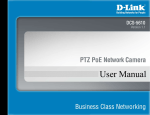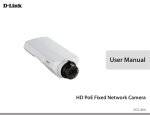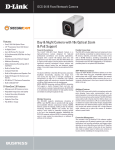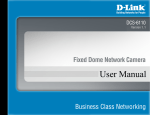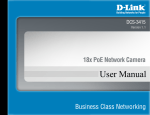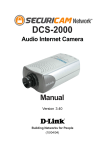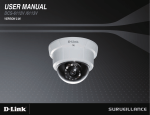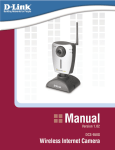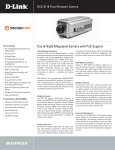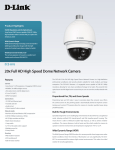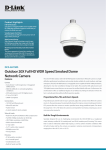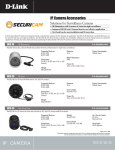Download Dlink DCS-5610 Manual
Transcript
Table of Contents
Table of Contents
Product Overview......................................................... 4
Package Contents.................................................... 4
System Requirements.............................................. 4
Introduction............................................................... 5
Features.................................................................... 6
Hardware Overview.................................................. 8
Connections........................................................ 8
LEDs................................................................... 9
Hardware Installation.............................................. 10
Software Installation.................................................. 12
Configuration.............................................................. 15
Setup Wizard Configuration.................................... 15
Web-based Configuration Utility............................. 20
Live Video............................................................... 21
Camera............................................................. 21
Snapshot........................................................... 22
Client Setup...................................................... 23
Setup...................................................................... 24
Wizard............................................................... 24
Internet Connection Setup Wizard................ 24
Motion Detection Setup Wizard..................... 29
Network Setup.................................................. 32
Dynamic DNS................................................... 35
Image Setup..................................................... 36
Audio and Video................................................ 37
Motion Detection............................................... 39
D-Link DCS-5610 User Manual
Time and Date.................................................. 40
Event Setup...................................................... 41
Add Server.................................................... 42
Add Media..................................................... 43
Add Event...................................................... 44
Recording......................................................... 45
Add Recording.............................................. 46
Camera Control................................................ 47
Access List........................................................ 49
DI and DO......................................................... 50
Maintenance........................................................... 51
Device Management......................................... 51
Backup and Restore......................................... 52
Firmware Update.............................................. 53
Status..................................................................... 54
Device Info........................................................ 54
Logs.................................................................. 55
Help........................................................................ 56
D-ViewCam Installation.............................................. 57
Add a Camera......................................................... 60
Frequently Asked Questions..................................... 65
Networking Basics..................................................... 68
Check your IP address........................................... 68
Statically Assign an IP address.............................. 69
Technical Specifications............................................ 70
Table of Contents
Contacting Technical Support................................... 73
Warranty...................................................................... 74
Registration................................................................. 80
D-Link DCS-5610 User Manual
Section 1 - Product Overview
Product
PackageOverview
Contents
• D-Link DCS-5610 PTZ PoE Internet Camera
• CAT5 Ethernet Cable
• Power Adapter
• Manual and Software on CD
• Quick Install Guide
• Camera Stand
Note: Using a power supply with a different voltage than the one
included with your product will cause damage and void the warranty
for this product.
If any of the above items are missing, please contact your reseller.
System Requirements
•Windows® XP or Windows Vista™
•At least 256MB of memory (512MB recommended)
•An available Ethernet connection
•Internet Explorer 6.x or higher Internet Web Browser
•VGA card resolution: 800x600 or above
•CPU: 1.7GHz or above processor (2.8GHz plus processor with 512MB memory and a 32MB video card
is required for multiple camera viewing and recording in IP surveillance program)
D-Link DCS-5610 User Manual
Section 1 - Product Overview
Introduction
The D-Link DCS-5610 PTZ (Pan, Tilt, and Zoom) PoE Internet Camera is a full featured surveillance system that connects
to an Ethernet, Fast Ethernet or broadband Internet connection to provide remote high-quality 2-Way Full Duplex audio,
and 2.6x optical and 4x digital zoom for greater clarity and detail from your recordings. The DCS-5610 is the latest product
added to the D-Link SECURICAM Network line. The DCS-5610 PTZ PoE Internet Camera differs from a conventional PC
Camera because it is a stand-alone system with a built-in CPU and Web server, capable of solving demanding security
and home/office monitoring needs. The PTZ PoE Internet Camera can be accessed remotely, and controlled, from any
PC or notebook computer over the Internet from anywhere in the world. The simple installation procedures, along with
the built-in Web-based interface offer easy integration to your network environments.
Note: Use of audio or video equipment for recording the image or voice of a person without their knowledge and
consent is prohibited in certain states or jurisdictions. Nothing herein represents a warranty or representation
that the D-Link product provided herein is suitable for the end-user’s intended use under the applicable laws of
his or her state. D-Link disclaims any liability whatsoever for any end-user use of the D-Link product, which fails
to comply with applicable state, local, or federal laws.
D-Link DCS-5610 User Manual
Section 1 - Product Overview
Features
•Motorized Pan and Tilt Operation - The DCS-5610 has a pan and tilt function that can expand your
viewing area to cover a wide 300o angle side-to-side and a 90o angle up and down.
•CCD Sensor - The DCS-5610 comes with a high quality CCD sensor that is superior to CMOS type sensor.
The variable focus glass lens will facilitate the use of the DCS-5610 providing crystal clear and sharp
images. You can view up to 30 frames per second of live motion video with 470 TV lines of resolution.
•Broad Range of Applications - With today’s high-speed Internet services, the PTZ PoE Internet Camera
can provide the ideal solution for live video images and audio over the Intranet and Internet for remote
monitoring. The DCS-5610 allows remote access from your Web browser for live image viewing with audio,
and allows the administrator to manage and control the PTZ PoE Internet Camera anytime and anywhere in
the world. Apply the Internet Camera to monitor various objects and places such as homes, offices, banks,
hospitals, child-care centers, amusement parks and other varieties of industrial and public monitoring. The
PTZ PoE Internet Camera can also be used for intruder detection with its motion-detection mode, capture
still images and video images for archiving, and many more applications such as sending images to an
FTP server or configuring for E-mail alerts. The DCS-5610 features 2-way Full-Duplex audio with a built-in
microphone that lets you remotely monitor and record audio with your video. With the addition of optional
speakers (not included), you can have 2-way Full-Duplex audio communication with the people you are
viewing. The DCS-5610 also features 2.6x optical and 4x digital zoom for closer viewing.
• Supports a Variety of Protocols - In addition, the DCS-5610 supports a variety of platforms including
RTSP, FTP, SMTP, NTP, and HTTP. The camera also supports UPnP and DDNS. DDNS allows your camera
to be accessed using a static host name rather than an IP address. UPnP will allow users of Windows®
XP to install the camera with a single mouse click.
D-Link DCS-5610 User Manual
Section 1 - Product Overview
• Audio Out - Connect a speaker to the camera so that a person in front of the camera can hear the person
on the other end of the communication.
• Web Configuration - Using a Web browser, administrators can configure and manage the PTZ PoE
Internet Camera directly from its own Web page via the Intranet or the Internet. Up to 20 user names and
passwords are permitted, with privilege settings controlled by the administrator.
• Powerful Surveillance and Remote Monitoring Utility - The powerful D-ViewCam software application
assigns an administrator with a pre-defined user ID and password who can modify the PTZ PoE Internet
Camera settings from the remote site via the Intranet or the Internet. Administrators are allowed to monitor
the image, record the image to a hard drive, take snapshots, and more.
• Connection to External Devices - Supporting auxiliary Input/Output connectors, you can connect the
PTZ PoE Internet Camera to a variety of external devices such as IR-sensors, switches and alarm relays.
Combined with programmable alarming equipment, you can develop a variety of security applications
that are triggered on alarm-based events. The PTZ PoE Internet Camera provides an industry standard
in/out external connector for connectivity.
• Internal/External Microphone - The SECURICAM Network DCS-5610 allows you to monitor video as well
as audio through the web browser. You have the option of using the DCS-5610’s integrated microphone or
your own external microphone using the connection located at the rear of the unit.
Note: Use of audio or video equipment for recording the image or voice of a person without their knowledge and consent is prohibited in
certain states or jurisdictions. Nothing herein represents a warranty or representation that the D-Link product provided herein is suitable
for the end-user’s intended use under the applicable laws of his or her state. D-Link disclaims any liability whatsoever for any end-user use
of the D-Link product, which fails to comply with applicable state, local, or federal laws.
D-Link DCS-5610 User Manual
Section 1 - Product Overview
Hardware Overview
Connections
Reset Button
Reset will be initiated when the reset
button is pressed once and held 30
seconds until the Power LED flashes
through its cycle twice.
DC Power Connector
The DC power input connector is located
on the DCS-5610 Internet Camera’s back
panel and is labeled 12V DC with a single
socket to supply power to the Internet
Camera.
MIC On/Off Switch
Used to turn the microphone on
or off.
Ethernet Cable Connector (PoE)
The Internet Camera’s back panel features an RJ-45 connector
for connections to 10Base-T Ethernet cabling or 100Base-TX Fast
Ethernet cabling. This network port supports the NWay protocol,
allowing the Internet Camera to automatically detect or negotiate
the transmission speed of the network. The Ethernet port can
also be used to power the camera using a PoE switch.
Audio Out Connector
The DCS-5610 provides an Audio Out connector
to be used for 2-way audio. Speakers (not
included) may be connected to the camera to
provide audio for 2-way communication.
I/O Connector
Microphone Connector
The DCS-5610 Internet Camera has an internal
microphone built-in. However, you have the option
of using an external microphone by plugging it into
the microphone connector.
D-Link DCS-5610 User Manual
The DCS-5610 provides a terminal block with two pairs of
connectors situated on the back panel. One pair is for input
and the other is for output. The I/O connectors provide the
physical interface to send and receive digital signals to and
from a variety of external devices.
Section 1 - Product Overview
Hardware Overview
LEDs
Power/MIC LED
The power LED is at the front base of the
camera. As soon as the power adapter is
connected to the camera, the LED will turn
red.
D-Link DCS-5610 User Manual
Activity LED
Once a connection has been established via
Ethernet port, the Activity LED will turn solid
green. If traffic is passing to the camera the
Activity LED will blink. If no Ethernet connection
is detected the Activity LED will not light up.
Section 1 - Product Overview
Hardware Installation
Connect the Ethernet Cable
Connect an Ethernet cable to the network cable connector located on the Internet Camera’s
back panel and attach it to the network.
Connect Using Power-Over-Ethernet
Once you connect an Ethernet cable to your PoE switch or adapter, the Power LED on the DCS-5610 will turn green
to indicate a proper connection.
Attach the External Power Supply
Attach the external power supply to the DC power input connector located on the Internet
Camera’s back panel (labeled DC 12V) and connect it to an AC power outlet.
Note: When you have a proper connection, the LED will turn green. The light may cycle
on and off and your computer may show an intermittent loss of connectivity, this is normal
until you have configured your Internet Camera.
D-Link DCS-5610 User Manual
10
Section 1 - Product Overview
The Internet Camera comes with a camera stand with a swivel ball screw head that can be attached to the Internet
Camera bottom socket cavity. Attach the camera stand to the Internet Camera and station it for your application. There
are holes located in the base of the camera stand allowing the Internet Camera to be mounted to the ceiling, or any
wall securely.
Socket for camera stand
D-Link DCS-5610 User Manual
11
Section 2 - Installation
Software Installation
Turn on the computer and Insert the D-Link DCS-5610 Autorun CD in the CD-ROM drive. The step-by-step instructions
that follow are shown in Windows® XP. The steps and screens are similar for the other Windows operating systems.
Click Installation Wizard
If the CD Autorun function does not automatically start on your computer, click Windows Start > Run. In the Run
command box type “D:\DCS5610.exe”, where D: represents the drive letter of your CD-ROM. If it does start, proceed
to the next screen.
D-Link DCS-5610 User Manual
12
Section 2 - Installation
Click Next to continue.
Click Next
Click I Agree to accept the License Agreement.
Click I Agree
D-Link DCS-5610 User Manual
13
Section 2 - Installation
To start the installation click Install.
Note: The installation may take several minutes to complete.
Click Install
Click Finish
D-Link DCS-5610 User Manual
14
Section 3 - Configuration
Configuration
This section will show you how to configure your new D-Link Internet Camera using the Installation Wizard.
Setup Wizard Configuration
Click on the D-Link Installation Wizard icon that was created in your Windows Start menu.
The Setup Wizard will appear and show the MAC address of the DCS-5610 and an IP Address (which may or may not
be correct depending on what you have your DCS-5610 connected to). If you have a DHCP server on your network,
there will be a valid IP Address displayed here.
Note: A DHCP server is a device that supplies the same IP address.
Click Manual Setup
D-Link DCS-5610 User Manual
15
Section 3 - Configuration
Enter the admin ID and password.
Note: The default Admin ID is admin with the password left blank.
Click Next
Select DHCP if you want to obtain a new IP address every time the
camera boots up.
Click Next
D-Link DCS-5610 User Manual
16
Section 3 - Configuration
Choose UPnP Port Forwarding if your router supports it, otherwise
choose Manual to enter your port numbers manually. Click Next to
continue.
Click Next
Enable DDNS and setup your DDNS service here, if you have
subscribed to a DDNS service. Click Next to continue.
Click Next
D-Link DCS-5610 User Manual
17
Section 3 - Configuration
If you want to access the DCS-5610 via mobile phone, click Yes
and the video resolution will be set to 176x144.
Click Apply to apply the settings to the device.
Click Apply
D-Link DCS-5610 User Manual
18
Section 3 - Configuration
Double-click the DCS-5610 to launch the camera’s web configuration
page.
D-Link DCS-5610 User Manual
19
Section 3 - Configuration
Web-based Configuration Utility
This section will show you how to configure your new D-Link Internet Camera using the Web-based Configuration
Utility.
To access the configuration utility, open a web-browser
such as Internet Explorer and enter the IP address of
your Internet Camera (http://192.168.0.120)
Note: In the example, this address is 192.168.0.120.
Your address may differ.
Type Admin in the user name field and leave the
password blank by default.
Note: You may refer to page 51 to change the password
for your admin account.
Click OK
D-Link DCS-5610 User Manual
20
Section 3 - Configuration
Live Video
Camera
This section shows your camera’s live video. You can control your settings using the buttons below.
Zoom: “-” zooms out, and “+” zooms in.
Pan Speed: Select the speed at which the camera will pan.
Tilt Speed: Select the speed at which the camera will tilt.
Zoom Speed: Select the speed at which the camera will zoom or
focus.
Pan: Pans the camera one full cycle.
Stop: Stops movement of the camera during pan.
Patrol: Enables the Patrol feature, please see page 50.
Go to: Select a preset position where the camera will
point.
D-Link DCS-5610 User Manual
21
Section 3 - Configuration
Snapshot
This section shows a snapshot image from your camera’s live video.
D-Link DCS-5610 User Manual
22
Section 3 - Configuration
Client Setup
You may configure and select the setting for your media streaming and recording
Stream Options: You can select which video stream profile to use.
Media Options: Allows the user to determine whether to receive only
video, audio, or both video & audio.
Protocol Options: There are 4 protocols for you to choose for the video
streaming.
UDP Protocol: This is recommended because it is an ideal protocol
for transmitting real-time audio and video data, which
can tolerate some lost packets.
UDP Unicast: Will stream to a single computer.
UDP Multicast Will stream to multiple computers using multicast.
TCP: Provides higher quality video streaming than UDP
does. It provides error correction and guarantees
packet to be delivered to client. However, transmission
speed will be reduced.
HTTP Protocol: Offers the highest image and video quality. However,
packet losses will diminish image quality when
bandwidth becomes restricted. If the network is
protected by a firewall and it opens HTTP port (80)
only, HTTP protocol must be selected. In this mode,
audio is disabled and only video can be viewed. UDP connections will not be available to remote users if all four ports have not
been forwarded (as shown on page 32). Only the HTTP port must be forwarded for remote users to make an HTTP connection
(video only).
Record Options: Allows the user to specify a destination folder and prefix filename for the recorded video.
D-Link DCS-5610 User Manual
23
Section 3 - Configuration
Setup
Wizard
To quickly configure your internet camera, click Internet
Connection Setup Wizard or click Manual Internet
Connection Setup to manually configure your internet
camera.
To quickly configure your internet camera’s motion
detection settings, click Motion Detection Setup Wizard
and skip to page 29. If you want to enter your settings
without running the wizard, click Manual Motion
Detection Setup and skip to page 39.
Internet Connection Setup Wizard
This wizard will guide you through a step-by-step process to configure your new D-Link Camera and connect the camera
to the internet. Click Next to continue.
Click Next
D-Link DCS-5610 User Manual
24
Section 3 - Configuration
Select DHCP if you are unsure which settings to pick.
Click Next to continue and skip to page 27.
Click Next
Select PPPoE if the camera is directly connected to the
Internet through a DSL modem, and the ISP (Internet
Service Provider) requires you to use PPPoE for the
Internet connection. Click Next to continue and skip to
Step 2 on page 26.
Click Next
D-Link DCS-5610 User Manual
25
Section 3 - Configuration
Select Static IP if your Internet Service Provider has
provided you with connection settings, or you wish to set
a static address within your home network. Click Next
to continue.
Click Next
If you have selected PPPoE, enter your username and
password. Click Next to continue.
Click Next
D-Link DCS-5610 User Manual
26
Section 3 - Configuration
If you have a Dynamic DNS account and would like the
camera to update your IP address automatically, enable
DDNS and enter your host information. Click Next to
continue.
Click Next
Enter a name for your camera and click Next to continue.
Click Next
Configure the correct time to ensure that all events will
be triggered, captured and scheduled at the right time.
Click Next to continue.
Click Next
D-Link DCS-5610 User Manual
27
Section 3 - Configuration
If you have selected DHCP, you will see a summary
of your camera’s settings. Please note down all this
information as you will need it for accessing your camera
within the network. Click Apply to save your settings.
Click Apply
If you have selected PPPoE, you will see a summary
of your camera’s settings. Please note down all this
information as you will need it for accessing your camera
within the network. Click Apply to save your settings.
Click Apply
If you selected Static IP, you will see a summary of your
camera’s settings. Please note down all this information
as you will need it for accessing your camera within the
network. Click Apply to save your settings.
Click Apply
D-Link DCS-5610 User Manual
28
Section 3 - Configuration
Motion Detection Setup Wizard
This wizard will guide you through a step-by-step process to configure your new D-Link Camera motion detection
functions. Click Next to continue.
Click Next
This section will allow you to enable or disable motion
detection as well as control the sensitivity or your
camera’s ability to detect movement. Specify the window
area, window name and sensitivity of detection as well
as the type of recording (either snapshot of video clip).
Then, click Next to continue.
Click Next
D-Link DCS-5610 User Manual
29
Section 3 - Configuration
This section will allows you to specify the time and date
your camera records motion.
Note: Recording camera footage will take up space
on your hard drive. Its recommended that you have
sufficient disk space for Always function.
Click Next
This step allows you to specify how you will receive the
events notification of your camera, either via using email
or FTP. You will need to enter all the relevant information
for your email account or FTP settings. Then, click Next
to continue.
Click Next
D-Link DCS-5610 User Manual
30
Section 3 - Configuration
You have completed the Motion Detection Wizard. Click
Apply to save your settings.
Click Apply
D-Link DCS-5610 User Manual
31
Section 3 - Configuration
Network Setup
LAN Settings: Settings for your local area network.
DHCP: Select this connection if you have a DHCP server running on your network
and would like a dynamic IP address to be updated to your camera
automatically.
Static IP Client: You may obtain a static or fixed IP address and other network information
from your network administrator for your camera. A static IP address will
ease you for accessing your camera in the future.
IP Address: The fixed IP address.
Subnet Mask: The default value is “255.255.255.0.” Used to determine if the destination
is in the same subnet.
Default Gateway: The gateway used to forward frames to destinations in a different subnet.
Invalid gateway settings may cause the failure of transmissions to a
different subnet.
Primary DNS: Primary domain name server that translates names to IP addresses.
Secondary DNS: Secondary domain name server to backup the primary one.
Enable UPnP Allows a user to find, view and control this camera via a presentation page
Presentation: or “Network Neighborhood” without configuration.
Enable UPnP Port Enables the camera to add the port forwarding entry into the router
Forwarding: automatically when this option is enabled.
PPPoE Settings: Enable this setting if your ISP (DSL service) is using PPPoE. You may
already have both Username and Password given by your ISP, or you may
check with your ISP. The Connect Status will be determined automatically
by the system.
D-Link DCS-5610 User Manual
32
Section 3 - Configuration
HTTP: You may configure two HTTP ports for your camera. HTTP ports allow you to connect to the camera via a standard web browser.
These ports can be set to a number other than the default TCP ports 80 and 8080. A corresponding port must be opened
on the router. For example, if the port is changed to 1010, users must type in the web browser “http://192.168.0.100:1010”
instead of “http://192.168.0.100”.
Authentication: Authentication: Choose either Basic where the password is not encrypted, or Digest where the password is encrypted
during the transmission to the web server.
HTTP Port: The default value is 80.
Secondary HTTP The default value is 8080.
Port: After you have enabled the Authentication, you will need to configure and use the access name to access your video file.
For example, http://camera ip/video.mjpg (video.mjpg is the Access name, you can modify it here)
Access name for The default name is video.mjpg.
stream1:
Access name for The default name is video2.mjpg.
stream2:
FTP Port: Default port is 21. If you want to change the port number, you will need to specify the port when connecting to the FTP server.
For example FTP://68.5.1.81:60 (if you use port 60 for your FTP server)
RTSP Streaming: This setting enables you to connect to a camera by using streaming mobile device(s), such as a mobile phone or PDA.
Authentication: Choose either Basic where the password is not encrypted, or Digest where the password is encrypted during the transmission
to the web server. After you have enabled the Authentication, you will need to configure and use the access name to access
your video file. RTSP://camera ip/live.sdp (live.sdp is the default access name, you can modify it here)
Access name for The default name is live.sdp.
stream1:
Access name for The default name is live2.sdp.
stream2:
D-Link DCS-5610 User Manual
33
Section 3 - Configuration
RTSP port: The port number that you use for RSTP streaming, the default port number is 554. RTP (Real Time Protocol) Port is used
to streaming audio and video while RTCP (Real Time Control Protocol) port is used to monitor QoS of RTP stream.
Note: RTP video port and RTP audio port must be an “even” number. The numbers of RTCP video port and RTCP audio
port must equal to the numbers of RTP video port and RTP audio port, plus one repetitively
RTP port for video: Default port number is 5556.
RTCP port for video: Default port number is 5557.
RTP port for audio: Default port number is 5558.
RTCP port for audio: Default port number is 5559.
You may choose to enable multicast for your camera audio and video streaming so that your cameras (sources) and the
receivers (clients) can establish the connection to send and receive contents.
Multicast group An IP Multicast group address is used to send and receive content. Sources use this group address as the destination
address: address while sending their data packets. Receivers use this group address to inform the network that they are interested
in receiving packets sent to that group.
For example, if some content is associated with group 239.1.1.1, the source will send data packets destined to 239.1.1.1.
Receivers for that content will inform the network that they are interested in receiving data packets sent to the group
239.1.1.1. The receiver “joins” 239.1.1.1. The Multicast address ranges from 224.0.0.0 to 239.255.255.255, or, equivalently,
224.0.0.0/4
Multicast video port: Default port number is 5560, or please choose between 1024 and 65534.
Multicast RTCP video Default port number is 5561, or please choose between 1024 and 65534.
port:
Multicast audio port: Default port number is 5562, or please choose between 1024 and 65534.
Multicast RTCP audio Default port number is 5563, or please choose between 1024 and 65534.
port:
Multicast TTL Set a Time to Live(TTL) value for multicast packet, please choose between 1 and 255.
{1~255]:
D-Link DCS-5610 User Manual
34
Section 3 - Configuration
Dynamic DNS
DDNS (Dynamic Domain Name Server) will hold a DNS host name and synchronize the public IP address of the modem
when it has been modified. The username and password are required when using the DDNS service.
Enable DDNS: Click to enable the DDNS function.
Server Name: Select your Dynamic DNS provider from the pull
down menu.
Host Name: Enter the host name of the DDNS server.
Username: Enter your username or e-mail used to connect
to the DDNS
Password: Enter your password used to connect to the DDNS
server.
Status: Indicate the connection status, automatically
determined by the system.
D-Link DCS-5610 User Manual
35
Section 3 - Configuration
Image Setup
You may configure the color, brightness, and orientation settings of the video image. Preview of the image will be shown
in the window of Live Video. Click Save Settings to save your changes.
Color: Select either for Color or B/W (black and white,
monochrome) video display.
Power line You may need to choose 50 or 60 Hz frequency;
frequency: and nonetheless maintain the system operation at
a basic 50 Hz frequency.
Video orientation: Two options. Flip will vertically rotate the video while
Mirror will horizontally rotate the video. You may
check both options if the camera is being installed
upside down.
White balance: Choose either Auto or Fix white balance.
Brightness: It has eleven levels ranged from -5 to +5 for you to
choose.
D-Link DCS-5610 User Manual
36
Section 3 - Configuration
Audio and Video
Two different settings for two video streams (stream 1 and stream 2) can be configured here. You may configure one
setting for computer display and the other one for mobile display.
Mode: It can be either JPEG or MPEG4. In JPEG mode,
the video frames are independent. However,
MPEG4 consumes much less network bandwidth
than JPEG.
Frame Size: Frame Size: Three options exist for the sizes of the
video display. You can select between 176x144,
352x240, or 640x480. It is recommended using
176x144 for mobile viewing and 640x480 for
computer viewing.
Maximum frame 1 is the minimum value while 30 is the maximum
rate: value. It is recommended choosing 30 for computer
viewing and 5 for mobile viewing.
Video quality: This limits the maximal refresh frame rate, which
can be combined with the “Fixed quality” to
optimize the bandwidth utilization and video quality.
If the User wants to fix the bandwidth utilization
regardless of the video quality, choose “Constant
bit rate” and select the desired bandwidth.
Mute: Select this if you want to switch off the sound.
Internal Select from the list to set internal microphone
microphone input input gain. It is necessary to find the optimum
gain: gain that transmits the best audio to whoever is
listening.
Note: dB stands for decibels, unit of audio
measurement. More decibels as a positive value indicates that the sound is louder, while more decibels as a negative value
indicates that the sound is quieter.
D-Link DCS-5610 User Manual
37
Section 3 - Configuration
External Select from the list to set external microphone input gain.
microphone
input:
Audio type: AAC (Advanced Audio Coding): A wide band audio coding algorithm that exploits two primary coding strategies to dramatically
reduce the amount of data needed to convey high-quality digital audio. Select a higher bit rate number for better audio
quality.
GSM-AMR: A standard adapted audio codec by the 3GPP video (3rd Generation Partnership Project). It is an Adaptive Multi Rate-Narrow
Band (AMR-NB) speech codec. Select a higher bit rate number for better audio quality.
AAC bit rate: Please select from the list, higher bit rate means higher audio quality but it takes more network bandwidth to transmit.
GSM-AMR bit Please select from the list, higher bit rate means higher audio quality but it takes more network bandwidth to transmit.
rate:
D-Link DCS-5610 User Manual
38
Section 3 - Configuration
Motion Detection
Enabling Motion Detection will allow up to three windows that can be created with different settings for monitoring. This
allows your camera to serve as a security device that will record when motion is detected.
Enable motion Check this option to turn on the motion detection.
detection:
Window name: Create your own name for the monitored area/
window. It will show at the top of the motion
window.
Sensitivity: Set the measurable difference between two
sequential images that would indicate motion.
Percentage: Set the amount of motion in the window being
monitored that is required to initiate a motion
detected alert. If this is set to 100%, this means
that motion is detected within the whole window
to trigger a snapshot.
Note: Setting a higher sensitivity and a lower
percentage will make any motion more easily.
New: Click to add a new window. A maximum of three
motion windows can be opened simultaneously.
Use your mouse to drag the window frame to
re-size or the title bar to move. Clicking on the ‘x’
at the upper right corner of the window will close
the window.
Save: Save the related settings of that window.
D-Link DCS-5610 User Manual
39
Section 3 - Configuration
Time and Date
From this section, you may automatically or manually configure, update and maintain the internal system clock for your
camera.
Current Server Will be determined by the system.
Time:
Time Zone: Select your time zone from the drop-down menu.
Enable Daylight Select this to enable the daylight saving time.
Saving:
Daylight Saving You may configure the daylight saving date and
Dates: time.
Automatic Time Enable this feature to obtain time configuration
Configuration: automatically from NTP server.
NTP Server: Network Time Protocol (NTP) synchronizes the
DCS-5610 with an Internet time server. Choose
the one that is closest to your location.
Update Interval: The time interval for updating the time information
from NTP server.
Set the date and This option allows you to set the time and date
time manually: manually.
Copy Your This will synchronize the time information from
Computer’s Time your PC.
Settings:
D-Link DCS-5610 User Manual
40
Section 3 - Configuration
Event Setup
There are three sections in Event Setup page. They are Event, Server and Media. Click Add to pop up a window to
add a new item of event, server or media. Click Delete to delete the selected item from the pull-down menu of event,
server or media. Click on the item name to pop up a window for modifying. You can add up to three events, five servers
and five medias.
D-Link DCS-5610 User Manual
41
Section 3 - Configuration
Add Server
Up to 5 servers, where will store the media with its own settings can be created and configured here.
Server Name: Unique name of your server.
Email: Select this to enable and apply your email account
setting for your camera.
FTP: Select this to access a granted folder on the
external FTP server.
HTTP: Select this to use a web server to store the
media.
Network Storage: Only one network storage is supported.
D-Link DCS-5610 User Manual
42
Section 3 - Configuration
Add Media
Up to 5 media for recording with its own settings can be created and configured here. There are three types of media,
Snapshot, Video Clip and System Log.
Media Name: The unique name for media.
Snapshot: Select this feature to enable camera to take
snapshot.
Source: The source of stream, stream1 or stream2.
Send pre-event The number of pre-event images.
image(s) [0~7]:
Send post-event The number of post-event images.
image(s) [0~7]:
File name prefix: The prefix name will be added on the file name of
the snapshot images.
Add date and time Check it to add timing information as file name
suffix to file name: suffix.
Video clip: Select this feature to enable camera to take video
clip.
Source: The source of stream, stream1 or stream2.
Pre-event recording: The interval of pre-event recording in seconds.
Maximum duration: The maximal recording file duration in seconds.
Maximum file size: The maximal file size would be generated.
File name prefix: The prefix name will be added on the file name of the video clip.
System log: Select this feature to enable camera to display system log.
D-Link DCS-5610 User Manual
43
Section 3 - Configuration
Add Event
Up to 3 events with its own settings can be created and configured here. Meanwhile, you can schedule the events
here.
Event name: Unique name for the event.
Enable this event: Select this to activate this event.
Priority: Set the priority for this event and the event with higher
priority will be executed first.
Delay: The delay time before checking next event. It is being
used for both events of motion detection and digital input
trigger.
Trigger: The input type that triggers the event.
Video motion Motion is detected during live video monitoring. Select
detection: the windows that need to be monitored.
Periodic: The event is triggered in specified intervals. The unit of
trigger interval is minute.
Digital input: External trigger input to the camera.
System boot: The event is triggered when the system boot up.
Time: Either “Always” or input the time interval.
Trigger D/O: Check it to trigger digital output for specific seconds when
event is triggered. The default actions are triggering the
D/O and storing the media on a CF card.
Move to preset If there is a server(s), user can select the available
location: server(s) from Move to preset location.
D-Link DCS-5610 User Manual
44
Section 3 - Configuration
Recording
Here you can configure and schedule the recording. You may add new entry or delete an existing entry via this page.
Recording entry: Available entry(s) is displayed here with its
details.
Add: Click this button to add new entry.
Delete: Delete an existing entry.
D-Link DCS-5610 User Manual
45
Section 3 - Configuration
Add Recording
You can add and configure an entry here.
Recording entry The unique name of the entry.
name:
Enable this Select this to enable the recording function.
recording:
Priority: Set the priority for this entry and the entry with
higher priority will be executed first.
Source: The source of stream.
Recording schedule: Scheduling the recording entry.
Recording settings: Configuring the setting for the recording.
Destination: Select the folder where will store the recording
file.
Total cycling Please input a HDD memory volume between
recording size: 1MB and 200GB for recording space. The
recording data will replace the oldest one when
total recording size exceeds this value. For
example, if each recording file is 6MB, and the
total cycling recording size is 600MB, then camera will recording 100 files to the specified location (folder). And then the
camera will delete the oldest file and create new file for cycling recording.
Please notice that if the HDD empty space is not enough, the recording will stop. Before you setup this option please make
sure you HDD have enough space and it is better not to save other files in the same folder as recording files.
Size of each file for File size for each recording file. You may input the value in the range of 200-6000.
recording:
File Name Prefix: The prefix name will be added on the file name of the recording file(s).
D-Link DCS-5610 User Manual
46
Section 3 - Configuration
Camera Control
Here you can preset the locations and change the default location for your home button.
Up, Down, Left, “Home” aims the camera to the center,
Right, Home: where as the other buttons aim the camera
accordingly.
Zoom (-): Zoom widely function.
Zoom (+): Zoom telescopically function
Pan Speed: Select the speed at which the camera will
pan for a full cycle from the pull down menu.
Select a value between -5 and +5, -5 being
the slowest setting.
Tilt Speed: Select the speed at which the camera will
tilt for a full cycle from the pull down menu.
Select a value between -5 and +5, -5 being
the slowest setting.
Zoom Speed: Select the speed at which the camera will
zoom for a full cycle from the pull down menu.
Select a value between -5 and +5, -5 being
the slowest setting.
Auto pan/patrol Select the speed at which the camera will pan
speed: during auto patrol. Select a value between 1
and 5, 1 being the slowest setting.
Dwelling time (sec): Set the value of time that the camera will remain on each preset position before moving to the next. The dwelling time
can be set between 1 and 255 seconds.
Preset locations: Desired positions that have been configured.
Selected locations: To use the Auto Patrol feature, select the desired preset positions from the Preset Locations list and add them to the
Selected Locations list by clicking Select. You can then select the order in which the camera will patrol through the preset
locations by selecting a location and clicking UP or DN. Click Remove to remove a location from the list.
D-Link DCS-5610 User Manual
47
Section 3 - Configuration
Current Enter a name for the position at which you would like to preset the DCS-5610. Click Add to add the new preset position to
Position: the Preset Locations list.
Preset A pull-down menu that contains all the preset locations. You can delete a preset position by selecting it and clicking Delete.
Position:
Home Allow users to set a new home position or default back to the original.
Location:
D-Link DCS-5610 User Manual
48
Section 3 - Configuration
Access List
Here you can configure the access permissions for each user.
Allow list: The list of IP addresses that have the access right
to the camera.
Start IP address: The starting IP Address of the devices (such as
a computer) that have permission to access the
video of the camera.
End IP address: The ending IP Address of the devices (such as
a computer) that have permission to access the
video of the camera.
Delete allow list: Remove the customized setting from the Allow
List.
Deny list: The list of IP addresses that have no access right
to the camera.
Delete deny list: Remove the customized setting from the Delete
List.
D-Link DCS-5610 User Manual
49
Section 3 - Configuration
DI and DO
The I/O connector provides the physical interface for digital output (DO) and digital input (DI) that is used for connecting
such external alarm devices as IR-Sensors and alarm relays to the PTZ IP camera.
DI and DO: Setting for both Digital input signal and digital
output signal can be configured here.
Digital input trigger Please select from “High” or “Low” for digital input
condition: trigger condition. When external device connect to
the digital input pins, the state of the voltage will
be monitored. (Max. Input 500mA, 12Vdc)
Digital output: Select Grounded or Open to define normal status
of the digital output. The camera will show whether
the trigger is activated or not.
D-Link DCS-5610 User Manual
50
Section 3 - Configuration
Maintenance
Device Management
You can modify both camera’s name and administrator’s password of your camera, as well as add more user accounts
for accessing the camera.
Admin password Modify a password for the administrator’s
setup: account.
Add user account: Add new user account.
Username: The username for the new account.
Password: The password for the new account.
Privilege: The access right for the new user.
Manage user: Managing the accounts for the existing users.
Authentication: The access right for the existing users.
Camera Name: Create a unique name for your camera and you
can access the camera using this name in your
web-browser. For example: http://DCS-5610 (By
default).
D-Link DCS-5610 User Manual
51
Section 3 - Configuration
Backup and Restore
You can turn off the front panel LED, restore factory default settings and reboot the camera.
Turn off the LED Check this option to turn off the LED next to the
indicator: lens. This will prevent anyone from observing the
operation of the IP Camera.
Restore: Click the button will reset the camera back to its
factory default settings. This will remove all the
configuration settings that were made previously.
Reboot: Click the button will restart the camera.
D-Link DCS-5610 User Manual
52
Section 3 - Configuration
Firmware Update
Your current firmware version and date will be displayed on your screen. You may go to the D-Link Support page to
check for the latest firmware version available.
To upgrade the firmware on your DCS-5610, please download and save the latest firmware version from the D-Link
Support page to your local hard drive. Locate the file on your local hard drive by clicking the Browse button. Then,
open the file and click the “Upload” button to start the firmware upgrade.
Current firmware It will be automatically determined and displayed
version: by the system.
Current firmware It will be automatically determined and displayed
date: by the system.
File Path: Locate the file (upgraded firmware) on your hard
drive using the browse feature.
Upload: Start uploading and upgrading the new firmware
to your camera.
D-Link DCS-5610 User Manual
53
Section 3 - Configuration
Status
Device Info
This page displays all the details information about your device and network connection.
D-Link DCS-5610 User Manual
54
Section 3 - Configuration
Logs
This page displays the log information of your camera. You can configure a remote log server so that you can view
your log details remotely.
Enable remote log: Enabling this feature so that the camera can send
camera log files to a remote server.
Log server settings: Configure the setting for the log server.
IP Address: The IP address of the remote server.
Port: The port number of the remote log server. The
default port is 514.
Save: Save the setting.
Current Log: The system log file that displayed by the system.
The content of the file reveals useful information
about camera configuration and connectivity
status after the camera boots up.
D-Link DCS-5610 User Manual
55
Section 3 - Configuration
Help
D-Link DCS-5610 User Manual
56
Section 4 - D-ViewCam Installation
D-ViewCam Installation
D-ViewCam software is included for the administrator to manage up to 32 D-Link IP cameras remotely. The administrator
can use the software to configure the advances settings for the camera. D-ViewCam is a complete management tool and
includes all configurative settings.
Insert the CD-ROM into the CD-ROM drive. A menu screen will appear as shown below.
Click D-ViewCam
D-ViewCam provides English, Traditional Chinese and Simplified
Chinese language versions. Select a language version and click OK to
continue.
Click OK
D-Link DCS-5610 User Manual
57
Section 4 - D-ViewCam Installation
Click Next to continue.
Click Next
Click Browse if you would like to choose a specific folder for the
installation, otherwise click Next to continue.
Click Next
D-Link DCS-5610 User Manual
58
Section 4 - D-ViewCam Installation
Click Next to start the installation.
Note: The D-ViewCam installation process may take several minutes to
complete.
Click Next
Click Finish to complete the installation.
Click Finish
D-Link DCS-5610 User Manual
59
Section 4 - D-ViewCam Installation
Add a Camera
This section will show you how to start and add a camera to the D-ViewCam system.
To start D-ViewCam, select Start > All Programs > D-Link >
D-Link D-ViewCam.
Enter admin as the default username and leave the password
blank. Click
/ OK to log into the system and access the Add
Camera Wizard.
Note: Please refer to page 48 in the D-ViewCam user manual
to change your password.
D-Link DCS-5610 User Manual
60
Section 4 - D-ViewCam Installation
Welcome to the Add Camera Wizard. Use this wizard to add your cameras to the D-ViewCam system.
Note: Use the left or right arrow to navigate the wizard.
Click
/ Next to continue.
Click Next
D-Link DCS-5610 User Manual
61
Section 4 - D-ViewCam Installation
Choose which method to add your camera(s). You can choose Auto
Discovery to automatically search for your camera(s), or choose Add
Manually to add your camera(s) via the camera’s IP address. Click Next
to continue.
If you choose Auto Discovery, the system will search all cameras that
are located on the same LAN with same subnet. The system will place all
the cameras at the default map called My Map. Click Next to continue.
If you choose Add Manually, you will need to enter the IP address of the
camera(s). Click Next to continue.
D-Link DCS-5610 User Manual
62
Section 4 - D-ViewCam Installation
D-ViewCam shows the detected IP camera(s) information. You can choose and schedule the recording for each
camera.
• 24/7 Continuous Recording: Continuously recording 24 hours a day, 7 days a week.
• 24/7 Motion Detection Recording: Continuously monitoring but ONLY recording when motion is detected.
• Office Hours Only: Continuously monitoring during office hours (08:00 AM to 06.00 PM) and ONLY recording
when motion is detected.
• Non-Office Hours Only: Continuously monitoring during non-office hours (06:00 PM to 08.00 AM) and ONLY
recording when motion is detected.
Note: Excluding 24/7 Continuous Recording, other schedule recording types can ONLY do recording when motion is
detected. Please refer to page 29 for more information.
Click Next to continue.
D-Link DCS-5610 User Manual
63
Section 4 - D-ViewCam Installation
Select Yes to add other camera(s), or select No if you have no additional
camera(s) to add. Click Next to continue.
The Add Camera wizard is now complete. Click Close to access the D-ViewCam’s main screen.
Your D-ViewCam Installation is Complete!
Note: Please refer to the D-ViewCam user manual for information
about using D-ViewCam.
D-Link DCS-5610 User Manual
64
Section 5 - Frequently Asked Questions
Frequently Asked Questions
This chapter provides solutions to problems that may occur during the installation and operation of the DCS-5610. Read
the following descriptions if you are having problems. (The examples below are illustrated in Windows® XP. If you have
a different operating system, the screenshots on your computer will look similar to the following examples.)
PTZ PoE Internet Camera Features
1. What is a PTZ PoE Internet Camera?
The PTZ PoE Internet Camera is a stand-alone system connecting directly to an Ethernet or Fast Ethernet network.
The PTZ PoE Internet Camera differs from a conventional PC Camera because it has an integrated system with built-in
CPU and web-based solutions, providing a low cost solution that can transmit high quality video images for monitoring.
The PTZ PoE Internet Camera can be remotely managed, accessed and controlled from any PC/Notebook over an
Intranet or Internet using a web browser.
2. What is the maximum number of users that can access DCS-5610 simultaneously?
The maximum number of users that can log onto the PTZ PoE Internet Camera at the same time is 10. Please keep in
mind the overall performance of the transmission speed will be reduced if many users have logged on to the camera
simultaneously.
3. What algorithm is used to compress the digital image?
The PTZ PoE Internet Camera utilizes MPEG-4 simple profile or MJPEG Mode image compression technology providing
high quality images. MJPEG is a standard for image compression and it can be applied to various web browsers and
application software without installing any extra software
4. Can I capture still images from the PTZ PoE Internet Camera?
Yes you can capture still images using the snapshot function.
D-Link DCS-5610 User Manual
65
Section 5 - Frequently Asked Questions
PTZ PoE Internet Camera Installation
1. Can the PTZ PoE Internet Camera be used outdoors?
The PTZ PoE Internet Camera is not weatherproof. It needs to be equipped with a weatherproof case for outdoor use
but it is not recommended.
2. When physically connecting the PTZ PoE Internet Camera to a network, what network cabling is required?
The PTZ PoE Internet Camera uses Category 5 UTP cable allowing 10 Base-T and 100 Base-T networking
solutions.
3. Can the PTZ PoE Internet Camera be setup as a PC-cam on a computer?
No, the PTZ PoE Internet Camera is used only on an Ethernet or Fast Ethernet network. The D-Link DSB-C110, DSBC310, can be used as a PC Camera (Webcam).
4. Can the PTZ PoE Internet Camera be connected to the network if it consists only of private IP addresses?
The PTZ PoE Internet Camera can be connected to a LAN with private IP addresses.
5. Can the PTZ PoE Internet Camera be installed and work if a firewall exists on the network?
If a firewall exists on the network, port 80 is open for ordinary data communication. The DCS-5610 uses port 5002 for
streaming audio and port 5003 for streaming video. These ports (or the ports you have specified in the Advanced Tab
in the Configuration screen) need to be opened on the firewall.
6. Why am I unable to access the PTZ PoE Internet Camera from a web browser?
If a router or firewall is used on the network, the correct ports for the DCS-5610 may not be configured on the router or
firewall. To correct the problem, you need to determine if the DCS-5610 is behind a router or firewall and if the router
or firewall is properly configured for the ports the DCS-5610 is using. Refer to Page 28 for help in opening the correct
ports on a router or firewall for use with the DCS-5610. Other possible problems might be due to the network cable.
Try replacing your network cable. Test the network interface of the product by connecting a local computer to the unit,
utilizing a Ethernet crossover cable. If the problem is not solved the PTZ PoE Internet Camera might be faulty.
D-Link DCS-5610 User Manual
66
Section 5 - Frequently Asked Questions
7. Why does the PTZ PoE Internet Camera work locally but not externally?
• This might be caused by network firewall protection. The setting of the firewall may need to be changed in order for the
PTZ PoE Internet Camera to be accessible outside of your local LAN. Check with the Network Administrator for your
network.
• Make sure that your PTZ PoE Internet Camera isn’t conflicting with any Web server you may have running on your
network.
• The default router setting might be a possible reason. Check that the configuration of the router settings allows the PTZ
PoE Internet Camera to be accessed outside of your local LAN.
8. I connected the PTZ PoE Internet Camera directly to a computer with a cross-over Ethernet cable and received
a Windows error upon running the installation Wizard?
• This Windows error will occur if the PTZ PoE Internet Camera is connected to a computer that is not properly
configured with a valid IP address. Turn off DHCP from the Network Settings in Windows and configure the
computer with a valid IP address or connect the camera to a router with DHCP enabled.
• This error can also occur if the Installation Wizard icon is clicked on more than once from the setup wizard.
9. Noisy images occur. How can I solve the problem?
The video images might be noisy if the PTZ PoE Internet Camera is used in a very low light environment. To solve this
issue you need more lighting.
10. The images appear to be of poor quality, how can I improve the image quality?
• Make sure that your computer’s display properties are set above 256 colors. Using 16 or 256 colors on your
computer will produce dithering artifacts in the image, making the image appear to be of poor quality.
• The configuration on the PTZ PoE Internet Camera image display is incorrect. Through the Advanced>Image Setup
section of the Web management you need to adjust the image related parameters such as brightness, white
balance and power line frequency for fluorescent light.
D-Link DCS-5610 User Manual
67
Appendix B - Networking Basics
Networking Basics
Check your IP address
After you install your new D-Link adapter, by default, the TCP/IP settings should be set to obtain an IP address from a
DHCP server (i.e. wireless router) automatically. To verify your IP address, please follow the steps below.
Click on Start > Run. In the run box type cmd and click OK.
At the prompt, type ipconfig and press Enter.
This will display the IP address, subnet mask, and
the default gateway of your adapter.
If the address is 0.0.0.0, check your adapter
installation, security settings, and the settings
on your access point. Some firewall software
programs may block a DHCP request on newly
installed adapters.
If you are connecting to a wireless network at a hotspot (e.g. hotel, coffee shop, airport), please contact an employee
or administrator to verify their wireless network settings.
D-Link DCS-5610 User Manual
68
Appendix B - Networking Basics
Statically Assign an IP address
If you are not using a DHCP capable gateway/access point, or you need to assign a static IP address, please follow
the steps below:
Step 1
Windows® XP - Click on Start > Control Panel > Network Connections.
Windows® 2000 - From the desktop, right-click My Network Places > Properties.
Step 2
Right-click on the Local Area Connection which represents your D-Link network adapter and select Properties.
Step 3
Highlight Internet Protocol (TCP/IP) and click Properties.
Step 4
Click Use the following IP address and enter an IP address that is on the same subnet as your network or the LAN
IP address on your access point.
Example: If the internet camera’s LAN IP address is 192.168.0.1, make your IP
address 192.168.0.X where X is a number between 2 and 99. Make sure that the
number you choose is not in use on the network. Set Default Gateway the same
as the LAN IP address of your access point (192.168.0.1).
Set Primary DNS the same as the LAN IP address of your access point (192.168.0.1).
The Secondary DNS is not needed or you may enter a DNS server from your
ISP.
Step 5
Click OK twice to save your settings.
D-Link DCS-5610 User Manual
69
Appendix C - Technical Specifications
Technical Specifications
Video Codec
MPEG4 / MJPEG
Audio Out
Yes
Audio Codec
GSM-AMR / MPEG-4 AAC
Mute Button
Slide switch for microphone mute (2 status)
PoE
Supported IEEE 802.3af standard Reset Button
Reset to factory default
Sensor
1/4” SONY progressive color CCD sensor
Dimension (WxHxD)
104 X 103.5 X 118 (mm)
SDRAM
32 Mbytes
Weight
319 (gram)
Flash Memory
8 Mbytes
Power Consumption
• Max 6W (estimate)
• Input: 100-240VAC, 50/60Hz
• Output: 12VDC, 1.5A
Lens
• 2.8-7.3mm zoom lens
• F1.9~F200 2.6x optical zoom (4x digital zoom)
LAN
• 10/100Base T ports x1
• IEEE 802.3 compliance
• IEEE 802.3u compliance
• Support Full-Duplex operations
• 802.3x Flow Control support for Full-Duplex mode
• Supported IEEE 802.3af standard (PoE)
MIC
6mm, -40 db ± 3db
I/O Connector
4pin-contact terminal block (1x input (2pins), 1x output(2pins)
D-Link DCS-5610 User Manual
Networking
Protocol
• IPV4, ARP, TCP, UDP, ICMP
• DHCP Client
• NTP Client (D-Link)
• DNS Client
• DDNS Client (D-Link)
• SMTP Client
• FTP Client
• HTTP Server
• Samba Client
• PPPoE
• UPnP Port Forwarding
• RTP
• RTSP
70
Appendix C - Technical Specifications
• RTCP
• IP filtering
• 3GPP
Ethernet
10/100M BaseT Fast Ethernet auto negotiation
Video
Algorithm Supported
MPEG4/MJPEG dual format compression simultaneously
JPEG for still image.
Features
• Adjustable image size and quality
• Time stamp and text overlay
• Three configurative motion detection windows
• Flip & mirror
Resolution
• 470 TV lines
• Up to 30 frames at 176x144
• Up to 30 frames at 320x240
• Up to 30 frames at 640x480
Low lux
1 Lux / F1.9
3A control
AGC, AWB, AES
Electronic shutter
1/60(1/50)~1/100,000sec
Sample rate
8/24/32K bps
D-Link DCS-5610 User Manual
Audio
Frequency
50 ~ 16000Hz
S/N ratio
More than 58dB
Mode
Full duplex 2-way audio communication
Directional
Omnidirectional
Microphone
Frequency
50 ~ 16000Hz
S/N ratio
6mm, - 40 dB + 3db
OS Support
Device
Windows 2000 / Windows XP / Windows Vista / 3GPP Mobile Phone
Utility
Windows 2000 / Windows XP / Windows Vista
Physical Environment
Power
• 12V 1.5A switching power adapter
• External AC-to-DC Switching Power Adapter
• Type: USA / UK / EUR / AUS / CN (Order by each territory)
Cable
• Cable Length: 1800 ± 30mm
• Type: UL 20AWGx2C (105°C) 300V
Plug
• Type: L type
• Connector Color: Black
71
Appendix C - Technical Specifications
Power Jack (On Device)
Color: Black
Operation Temperature
0 to 40 °C (32 to 104°F)
Storage Temperature
- 20 to 70 °C (-4 to 158 °F)
Humidity
20-80% RH non-condensing
Emission (EMI), Safety & Other Certifications
• FCC
• CE
• C-Tick
Maximum wireless signal rate derived from IEEE Standard 802.11g, 802.11a and Draft 802.11n specifications. Actual data throughput will vary. Network conditions and
environmental factors, including volume of network traffic, building materials and construction, and network overhead, lower actual data throughput rate. Environmental
conditions will adversely affect wireless signal range.
2
Range varies depending on country’s regulation.
3
The DCS-5610 doesn’t include 5.25-5.35GHz & 5.47~5.725GHz.
1
D-Link DCS-5610 User Manual
72
Appendix D - Contacting Technical Support
Contacting Technical Support
U.S. and Canadian customers can contact D-Link technical support through our web site or by phone.
Before you contact technical support, please have the following ready:
• Model number of the product (e.g. DCS-5610)
• Hardware Revision (located on the label on the bottom of the internet camera (e.g. rev A1))
• Serial Number (s/n number located on the label on the bottom of the internet camera).
You can find software updates and user documentation on the D-Link website as well as frequently asked questions
and answers to technical issues.
For customers within the United States:
For customers within Canada:
Phone Support:
(877) 453-5465
Phone Support:
(800) 361-5265
Internet Support:
http://support.dlink.com
Internet Support:
http://support.dlink.com
D-Link DCS-5610 User Manual
73
Appendix E - Warranty
Warranty
Subject to the terms and conditions set forth herein, D-Link Systems, Inc. (“D-Link”) provides this Limited Warranty:
• Only to the person or entity that originally purchased the product from D-Link or its authorized reseller or distributor, and
• Only for products purchased and delivered within the fifty states of the United States, the District of Columbia, U.S. Possessions or Protectorates, U.S. Military Installations, or addresses with an APO or FPO.
Limited Warranty:
D-Link warrants that the hardware portion of the D-Link product described below (“Hardware”) will be free from material defects in
workmanship and materials under normal use from the date of original retail purchase of the product, for the period set forth below
(“Warranty Period”), except as otherwise stated herein.
• Hardware (excluding power supplies and fans): One (1) year
• Power supplies and fans: One (1) year
• Spare parts and spare kits: Ninety (90) days
The customer’s sole and exclusive remedy and the entire liability of D-Link and its suppliers under this Limited Warranty will be, at
D-Link’s option, to repair or replace the defective Hardware during the Warranty Period at no charge to the original owner or to refund the
actual purchase price paid. Any repair or replacement will be rendered by D-Link at an Authorized D-Link Service Office. The replacement
hardware need not be new or have an identical make, model or part. D-Link may, at its option, replace the defective Hardware or any part
thereof with any reconditioned product that D-Link reasonably determines is substantially equivalent (or superior) in all material respects
to the defective Hardware. Repaired or replacement hardware will be warranted for the remainder of the original Warranty Period or ninety
(90) days, whichever is longer, and is subject to the same limitations and exclusions. If a material defect is incapable of correction, or if
D-Link determines that it is not practical to repair or replace the defective Hardware, the actual price paid by the original purchaser for the
defective Hardware will be refunded by D-Link upon return to D-Link of the defective Hardware. All Hardware or part thereof that is replaced
by D-Link, or for which the purchase price is refunded, shall become the property of D-Link upon replacement or refund.
D-Link DCS-5610 User Manual
74
Appendix E - Warranty
Limited Software Warranty:
D-Link warrants that the software portion of the product (“Software”) will substantially conform to D-Link’s then current functional specifications
for the Software, as set forth in the applicable documentation, from the date of original retail purchase of the Software for a period of ninety
(90) days (“Software Warranty Period”), provided that the Software is properly installed on approved hardware and operated as contemplated
in its documentation. D-Link further warrants that, during the Software Warranty Period, the magnetic media on which D-Link delivers the
Software will be free of physical defects. The customer’s sole and exclusive remedy and the entire liability of D-Link and its suppliers under
this Limited Warranty will be, at D-Link’s option, to replace the non-conforming Software (or defective media) with software that substantially
conforms to D-Link’s functional specifications for the Software or to refund the portion of the actual purchase price paid that is attributable
to the Software. Except as otherwise agreed by DLink in writing, the replacement Software is provided only to the original licensee, and
is subject to the terms and conditions of the license granted by D-Link for the Software. Replacement Software will be warranted for the
remainder of the original Warranty Period and is subject to the same limitations and exclusions. If a material non-conformance is incapable
of correction, or if D-Link determines in its sole discretion that it is not practical to replace the non-conforming Software, the price paid by
the original licensee for the non-conforming Software will be refunded by D-Link; provided that the non-conforming Software (and all copies
thereof) is first returned to D-Link. The license granted respecting any Software for which a refund is given automatically terminates.
Non-Applicability of Warranty:
The Limited Warranty provided hereunder for Hardware and Software portions of D-Link’s products will not be applied to and does not cover
any refurbished product and any product purchased through the inventory clearance or liquidation sale or other sales in which D-Link, the
sellers, or the liquidators expressly disclaim their warranty obligation pertaining to the product and in that case, the product is being sold
“As-Is” without any warranty whatsoever including, without limitation, the Limited Warranty as described herein, notwithstanding anything
stated herein to the contrary.
Submitting A Claim:
The customer shall return the product to the original purchase point based on its return policy. In case the return policy period has expired
and the product is within warranty, the customer shall submit a claim to D-Link as outlined below:
• The customer must submit with the product as part of the claim a written description of the Hardware defect or Software
nonconformance in sufficient detail to allow DLink to confirm the same, along with proof of purchase of the product (such
as a copy of the dated purchase invoice for the product) if the product is not registered.
• The customer must obtain a Case ID Number from D-Link Technical Support at 1-877-453-5465, who will attempt to assist
the customer in resolving any suspected defects with the product. If the product is considered defective, the customer must
obtain a Return Material Authorization (“RMA”) number by completing the RMA form and entering the assigned Case ID
Number at https://rma.dlink.com/.
D-Link DCS-5610 User Manual
75
Appendix E - Warranty
• After an RMA number is issued, the defective product must be packaged securely in the original or other suitable shipping
package to ensure that it will not be damaged in transit, and the RMA number must be prominently marked on the outside
of the package. Do not include any manuals or accessories in the shipping package. DLink will only replace the defective
portion of the product and will not ship back any accessories.
• The customer is responsible for all in-bound shipping charges to D-Link. No Cash on Delivery (“COD”) is allowed. Products
sent COD will either be rejected by D-Link or become the property of D-Link. Products shall be fully insured by the customer
and shipped to D-Link Systems, Inc., 17595 Mt. Herrmann, Fountain Valley, CA 92708. D-Link will not be held responsible
for any packages that are lost in transit to D-Link. The repaired or replaced packages will be shipped to the customer via
UPS Ground or any common carrier selected by D-Link. Return shipping charges shall be prepaid by D-Link if you use an
address in the United States, otherwise we will ship the product to you freight collect. Expedited shipping is available upon
request and provided shipping charges are prepaid by the customer. D-Link may reject or return any product that is not
packaged and shipped in strict compliance with the foregoing requirements, or for which an RMA number is not visible from
the outside of the package. The product owner agrees to pay D-Link’s reasonable handling and return shipping charges
for any product that is not packaged and shipped in accordance with the foregoing requirements, or that is determined by
D-Link not to be defective or non-conforming.
What Is Not Covered:
The Limited Warranty provided herein by D-Link does not cover:
Products that, in D-Link’s judgment, have been subjected to abuse, accident, alteration, modification, tampering, negligence, misuse, faulty
installation, lack of reasonable care, repair or service in any way that is not contemplated in the documentation for the product, or if the
model or serial number has been altered, tampered with, defaced or removed; Initial installation, installation and removal of the product for
repair, and shipping costs; Operational adjustments covered in the operating manual for the product, and normal maintenance; Damage
that occurs in shipment, due to act of God, failures due to power surge, and cosmetic damage; Any hardware, software, firmware or other
products or services provided by anyone other than D-Link; and Products that have been purchased from inventory clearance or liquidation
sales or other sales in which D-Link, the sellers, or the liquidators expressly disclaim their warranty obligation pertaining to the product.
While necessary maintenance or repairs on your Product can be performed by any company, we recommend that you use only an Authorized
D-Link Service Office. Improper or incorrectly performed maintenance or repair voids this Limited Warranty.
Disclaimer of Other Warranties:
EXCEPT FOR THE LIMITED WARRANTY SPECIFIED HEREIN, THE PRODUCT IS PROVIDED “AS-IS” WITHOUT ANY WARRANTY
OF ANY KIND WHATSOEVER INCLUDING, WITHOUT LIMITATION, ANY WARRANTY OF MERCHANTABILITY, FITNESS FOR A
PARTICULAR PURPOSE AND NONINFRINGEMENT.
D-Link DCS-5610 User Manual
76
Appendix E - Warranty
IF ANY IMPLIED WARRANTY CANNOT BE DISCLAIMED IN ANY TERRITORY WHERE A PRODUCT IS SOLD, THE DURATION OF
SUCH IMPLIED WARRANTY SHALL BE LIMITED TO THE DURATION OF THE APPLICABLE WARRANTY PERIOD SET FORTH ABOVE.
EXCEPT AS EXPRESSLY COVERED UNDER THE LIMITED WARRANTY PROVIDED HEREIN, THE ENTIRE RISK AS TO THE QUALITY,
SELECTION AND PERFORMANCE OF THE PRODUCT IS WITH THE PURCHASER OF THE PRODUCT.
Limitation of Liability:
TO THE MAXIMUM EXTENT PERMITTED BY LAW, D-LINK IS NOT LIABLE UNDER ANY CONTRACT, NEGLIGENCE, STRICT LIABILITY
OR OTHER LEGAL OR EQUITABLE THEORY FOR ANY LOSS OF USE OF THE PRODUCT, INCONVENIENCE OR DAMAGES OF ANY
CHARACTER, WHETHER DIRECT, SPECIAL, INCIDENTAL OR CONSEQUENTIAL (INCLUDING, BUT NOT LIMITED TO, DAMAGES FOR
LOSS OF GOODWILL, LOSS OF REVENUE OR PROFIT, WORK STOPPAGE, COMPUTER FAILURE OR MALFUNCTION, FAILURE OF
OTHER EQUIPMENT OR COMPUTER PROGRAMS TO WHICH D-LINK’S PRODUCT IS CONNECTED WITH, LOSS OF INFORMATION
OR DATA CONTAINED IN, STORED ON, OR INTEGRATED WITH ANY PRODUCT RETURNED TO D-LINK FOR WARRANTY SERVICE)
RESULTING FROM THE USE OF THE PRODUCT, RELATING TO WARRANTY SERVICE, OR ARISING OUT OF ANY BREACH OF
THIS LIMITED WARRANTY, EVEN IF D-LINK HAS BEEN ADVISED OF THE POSSIBILITY OF SUCH DAMAGES. THE SOLE REMEDY
FOR A BREACH OF THE FOREGOING LIMITED WARRANTY IS REPAIR, REPLACEMENT OR REFUND OF THE DEFECTIVE OR
NONCONFORMING PRODUCT. THE MAXIMUM LIABILITY OF D-LINK UNDER THIS WARRANTY IS LIMITED TO THE PURCHASE
PRICE OF THE PRODUCT COVERED BY THE WARRANTY. THE FOREGOING EXPRESS WRITTEN WARRANTIES AND REMEDIES
ARE EXCLUSIVE AND ARE IN LIEU OF ANY OTHER WARRANTIES OR REMEDIES, EXPRESS, IMPLIED OR STATUTORY.
Governing Law:
This Limited Warranty shall be governed by the laws of the State of California. Some states do not allow exclusion or limitation of incidental
or consequential damages, or limitations on how long an implied warranty lasts, so the foregoing limitations and exclusions may not apply.
This Limited Warranty provides specific legal rights and you may also have other rights which vary from state to state.
Trademarks:
D-Link is a registered trademark of D-Link Corporation/D-Link Systems, Inc. Other trademarks or registered trademarks are the property
of their respective owners.
Copyright Statement:
No part of this publication or documentation accompanying this product may be reproduced in any form or by any means or used to make
any derivative such as translation, transformation, or adaptation without permission from D-Link Corporation/D-Link Systems, Inc., as
stipulated by the United States Copyright Act of 1976 and any amendments thereto. Contents are subject to change without prior notice.
Copyright ©2008 by D-Link Corporation/D-Link Systems, Inc. All rights reserved.
D-Link DCS-5610 User Manual
77
Appendix E - Warranty
CE Mark Warning:
This is a Class B product. In a domestic environment, this product may cause radio interference, in which case the user may be required
to take adequate measures.
FCC Statement:
This equipment has been tested and found to comply with the limits for a Class B digital device, pursuant to part 15 of the FCC Rules.
These limits are designed to provide reasonable protection against harmful interference in a residential installation. This equipment
generates, uses, and can radiate radio frequency energy and, if not installed and used in accordance with the instructions, may cause
harmful interference to radio communication. However, there is no guarantee that interference will not occur in a particular installation. If
this equipment does cause harmful interference to radio or television reception, which can be determined by turning the equipment off
and on, the user is encouraged to try to correct the interference by one or more of the
following measures:
• Reorient or relocate the receiving antenna.
• Increase the separation between the equipment and receiver.
• Connect the equipment into an outlet on a circuit different from that to which the receiver is connected.
• Consult the dealer or an experienced radio/TV technician for help.
FCC Caution:
Any changes or modifications not expressly approved by the party responsible for compliance could void the user’s authority to operate
this equipment.
This device complies with Part 15 of the FCC Rules. Operation is subject to the following two conditions:
(1) This device may not cause harmful interference, and (2) this device must accept any interference received, including interference that
may cause undesired operation.
If this device is going to be operated in 5.15 ~ 5.25GHz frequency range, then it is restricted in indoor environment only.
IMPORTANT NOTICE:
FCC Radiation Exposure Statement:
This equipment complies with FCC radiation exposure limits set forth for an uncontrolled environment. This equipment should be installed
and operated with minimum distance 20cm between the radiator & your body. This transmitter must not be co-located or operating in
conjunction with any other antenna or transmitter.
The availability of some specific channels and/or operational frequency bands are country dependent and are firmware programmed at
the factory to match the intended destination. The firmware setting is not accessible by the end user.
D-Link DCS-5610 User Manual
78
Appendix E - Warranty
For detailed warranty information applicable to products purchased outside the United States, please contact the corresponding local
D-Link office.
Industry Canada Notice:
This device complies with RSS-210 of the Industry Canada Rules. Operation is subject to the following two conditions:
(1) This device may not cause harmful interference, and (2) this device must accept any interference received, including interference that
may cause undesired operation.
IMPORTANT NOTE:
Radiation Exposure Statement:
This equipment complies with IC radiation exposure limits set forth for an uncontrolled environment. This equipment should be installed
and operated with minimum distance 20cm between the radiator & your body.
This device has been designed to operate with an antenna having a maximum gain of 2 dB. Antenna having a higher gain is strictly
prohibited per regulations of Industry Canada. The required antenna impedance is 50 ohms.
D-Link DCS-5610 User Manual
79
Appendix F - Registration
Registration
Product registration is entirely voluntary and failure to complete or return this form will not diminish your warranty
rights.
Version 1.0
February 26, 2007
D-Link DCS-5610 User Manual
80
















































































